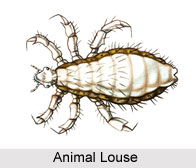 Animal Louse is the highly specialized wingless insect of the Phthiraptera order. Animal lice (plural form) have risen from psocid ancestors. There are three distinct suborders among them. They are namely Anoplura (sucking lice), Mallophaga (chewing or biting lice) and the peculiar Rhynchophthirina or elephant lice that include only Haematomyzus. Around 3000 species of these highly modified, parasitic insects are known. They are dorso-ventrally flattened; lack wings and their tarsi are adapted for clinging to the host body. Some are hard-bodied or just pigmented and many have hairy bodies while others are bare.
Animal Louse is the highly specialized wingless insect of the Phthiraptera order. Animal lice (plural form) have risen from psocid ancestors. There are three distinct suborders among them. They are namely Anoplura (sucking lice), Mallophaga (chewing or biting lice) and the peculiar Rhynchophthirina or elephant lice that include only Haematomyzus. Around 3000 species of these highly modified, parasitic insects are known. They are dorso-ventrally flattened; lack wings and their tarsi are adapted for clinging to the host body. Some are hard-bodied or just pigmented and many have hairy bodies while others are bare.
Eating Pattern of Animal Louse
In general, the Mallophaga feed on feathers of birds while the Anoplura feed exclusively on blood of mammals. They are highly host-specific. More than 5 or 6 species of lice may parasitize a single bird species, each occupying specific body regions of the host concerned. Mammal lice are less restricted and generally move slower than bird lice, both being negatively phototropic. Transfer of lice from one host individual to another is solely by direct contact, some moving from predator to prey or vice versa, and some of them exhibit phoresy that is they get transported by using the body of other animals. The number of lice on a single host may vary from less than 10 to over 1000 individuals, depending on the host size usually. Adult lice live only for around two weeks, but the human lice may survive for a month.
Hatching of Animal Louse
Eggs are laid cemented to host hairs or feathers and high humidity is not particularly suitable to development. Larvae hatch within a week and live on the host as do the adult lice.
Enemies of Animal Louse
Lice have almost no natural enemies except their hosts, which kill lice by grooming, preening and scratching, or even by eating their lice parasites. The dust-bathing and `anting` habits of birds probably are directed to ridding themselves of excessive lice.
Effects of Louse on Human and Livestock
The human louse, Pediculus humanus, is found in two forms depending on the host region it inhabits: the head louse and the body louse. Human lice are vectors of endemic typhus; French fever and relapsing fever in man. Livestock heavily infested with lice may cause considerable production losses in wool, meat, dairy and poultry industries. Lipeurus tropicalis, Haema-topinus tuberculatus, Trichodectes canis and Columbicola columbae are the more common species.



















